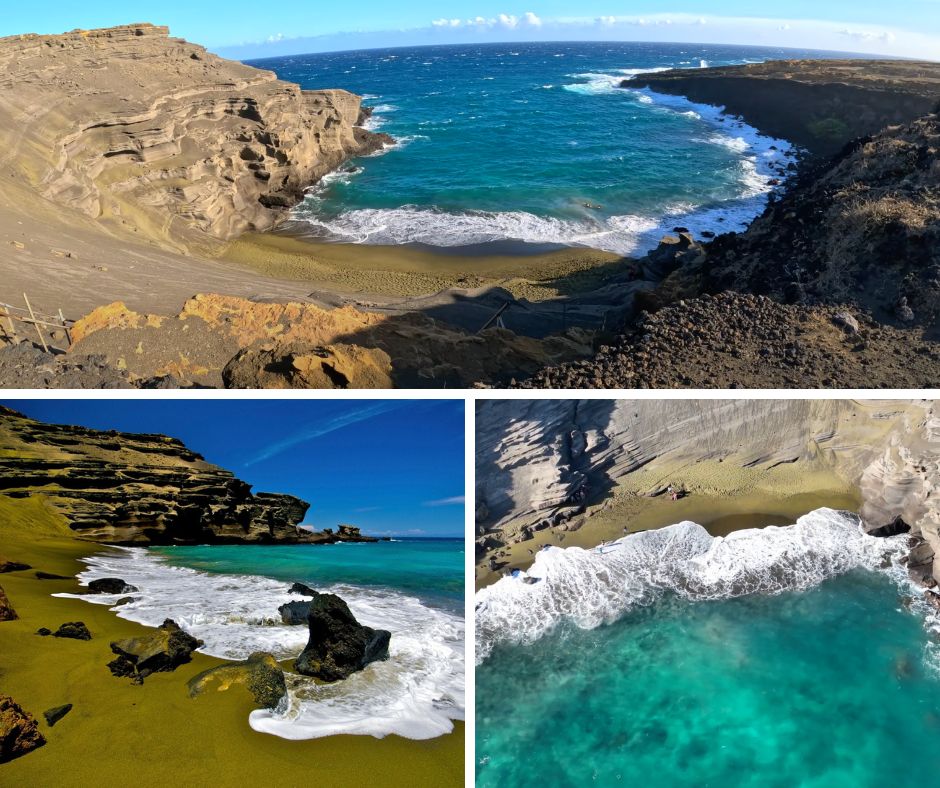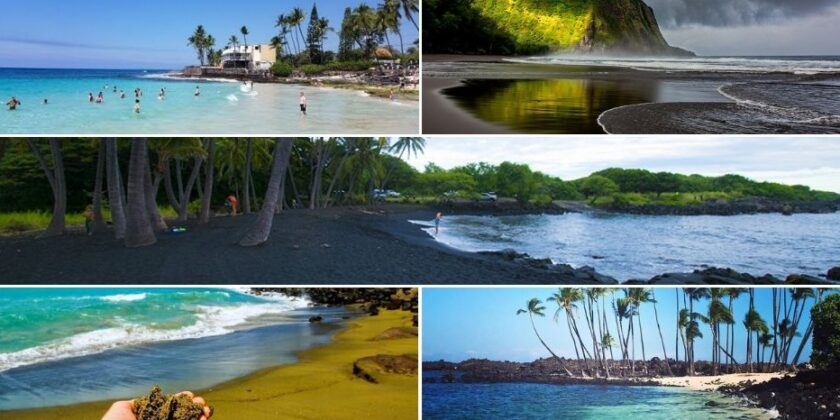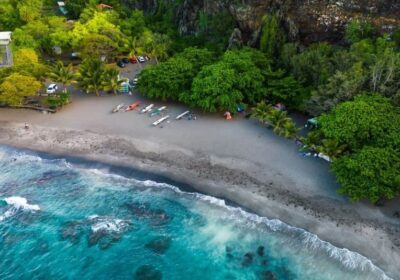The Big Island of Hawaiʻi isn’t just about volcanoes and waterfalls—it’s also home to some of the most unique and breathtaking beaches in the world. From white sand to green sand, and even jet-black shores, these five must-see beaches each offer something unforgettable.
Embark on a coastal journey through paradise where black volcanic shores meet crystal waters and hidden coves await the adventurous spirit.
The Big Island of Hawaii, with its diverse landscapes and geological wonders, offers beach experiences unlike anywhere else on Earth. From pristine white sands to dramatic black volcanic shores, the island’s beaches tell the story of its fiery birth and continuous evolution. As a professional tour guide who has spent countless days exploring these coastal treasures, I’m thrilled to share with you the five most extraordinary beaches that showcase the true essence of Hawaii’s largest island.
Here’s your ultimate bucket list for the Best Beaches on the Big Island of Hawaii
1. Hapuna Beach State Recreation Area

Location: Kohala Coast (Northwest Big Island
Why Hapuna is one of the Best Beaches on the Big Island of Hawaii
Consistently ranked among the best beaches in the United States, Hapuna Beach is a dream for sun-seekers and swimmers alike. Its half-mile stretch of soft white sand and clear, turquoise waters make it perfect for swimming, boogie boarding, or simply soaking up the Hawaiian sun. It’s one of the few Big Island beaches with lifeguards, restrooms, and shaded picnic areas—ideal for a full beach day.
2. Punaluʻu Black Sand Beach

Location: Kau District (South Big Island)
Why Punaluʻu is one of the Best Beaches on the Big Island of Hawaii
Punaluʻu Beach offers one of the most visually striking landscapes in the Hawaiian archipelago. The jet-black sand, formed from lava meeting the sea, creates a dramatic contrast against the blue ocean and is often graced by endangered Hawaiian green sea turtles (honu) basking on shore.
This beach tells a powerful story of the island’s volcanic creation. As you walk across the dark shore, you’re literally stepping on the pulverized remains of lava flows that, over time, were crushed by the relentless ocean into fine, black sand. It’s a tangible connection to the geological forces that created the Hawaiian Islands.
Beyond its unique appearance, Punaluʻu is a sanctuary for wildlife observation. The resident sea turtles often come ashore to rest (please remember to keep a respectful distance of at least 10 feet), and the nearby freshwater springs attract various bird species, creating a natural habitat unlike any other beach setting.
3. Makalawena Beach

Location: Kekaha Kai State Park, North Kona
Why Makalawena is one of the Best Beaches on the Big Island of Hawaii
For those seeking a true escape from civilization, Makalawena Beach rewards the adventurous with pristine isolation. Accessible primarily by foot, this “sandy utopia is literally off-the-beaten-path” requiring a hike across rugged lava fields, which naturally limits crowds and preserves its untouched beauty.
The journey to reach Makalawena is part of what makes it special. The trail leads across a “very hot, very dry, barren a’a lava field” for about 20 minutes before revealing the “sand dunes behind Makalawena Beach”. This effort filters out casual beachgoers, ensuring that those who make the trek are rewarded with ample space and tranquility.
Upon arrival, you’ll discover a series of curved bays with powder-soft white sand, crystalline waters in varying shades of turquoise, and enough shade from scattered palm trees to escape the midday sun. Swimming is usually safe when waters are calm, and the most northerly bay features “a protected spot that’s very calm” – perfect for a refreshing dip after your hike.
The beach’s remote nature means facilities are non-existent, so come prepared with plenty of water, snacks, and sun protection. This is Hawaii at its most authentic – raw, beautiful, and unforgettable.
4. Green Sand Beach (Papakōlea Beach)

Location: Near South Point (Ka Lae), Southern Tip of the Island
Why Papakōlea is one of the Best Beaches on the Big Island of Hawaii
Papakōlea Beach represents one of our planet’s rarest natural phenomena – one of only four green sand beaches in the world. The beach’s distinctive olivine crystals, which give the sand its green hue, are “washed out of the old cinder cone next to the beach”, creating a geological marvel that must be seen to be believed.
Reaching this remote treasure requires commitment: a “5.5-mile round-trip hike with an elevation gain of only 275 feet” through surrounding pasturelands. The trek to Papakōlea takes you along the windswept southern coastline of the island, where the vast Pacific stretches uninterrupted all the way to Antarctica.
Upon arrival, the beach nestles within the remains of a 49,000-year-old volcanic cinder cone, whose olivine-rich walls continue to supply the shore with its green sand. The color ranges from olive to almost emerald depending on the light, creating a surreal landscape that contrasts dramatically with the deep blue ocean beyond.
Swimming here can be challenging due to strong currents, but even if you only come to witness this colorful geological wonder, the journey is well worth the effort for the unique photographs and memories you’ll create.
5. Waipiʻo Valley Black Sand Beach

Location: North Hamakua Coast
Why Waipiʻo Valley Black Sand is one of the Best Beaches on the Big Island of Hawaii
Framed by towering 2,000-foot cliffs and lush rainforest, the black sand beach at Waipiʻo Valley embodies the mystical side of Hawaii’s natural beauty. This “gorgeous black sand beach” sits at the mouth of the valley known as “the Valley of the Kings,” believed to be “one of the first places inhabited on the Big Island, where native Hawaiians have grown kalo (taro) for thousands of years”.
The journey to Waipiʻo is as memorable as the destination itself. As of 2025, access to the valley floor is restricted to protect both the land and visitors. Currently, due to road safety concerns, the “Waipi’o Valley Road was closed to hikers and vehicles that do not belong to residents or workers needing to access their property in the valley”. The best way to experience this sacred place is through the “Waipio Valley Shuttle Tour,” which is “owned and operated by local families who call the valley home”.
From the black sand shoreline, you’ll witness incredible waterfalls cascading from distant cliffs, including Hi’ilawe Falls – one of Hawaii’s tallest waterfalls. The powerful waves crashing against the shore, the verdant valley walls, and the sense of stepping back in time to ancient Hawaii create an almost spiritual experience.
This beach represents more than just natural beauty – it’s a living connection to Hawaiian history and culture, where you can sense the mana (spiritual energy) that has made this valley revered for generations.
Tips for Your Big Island Beach Adventures
- Respect the Elements: Hawaii’s sun is intense, especially at beaches with limited shade like Makalawena and Papakōlea. Bring plenty of reef-safe sunscreen, hats, and water.
- Check Conditions: Ocean conditions can change rapidly. When in doubt, stay out – especially at beaches without lifeguards.
- Leave No Trace: Pack out everything you bring in, especially at remote beaches that lack facilities.
- Respect Wildlife: Maintain a respectful distance from sea turtles, monk seals, and other marine life you might encounter.
- Time Your Visits: Early mornings offer the calmest waters and best lighting for photographs, while providing more time for hikes to remote locations like Makalawena and Papakōlea.
The Big Island’s beaches are more than just places to swim and sunbathe – they’re windows into the island’s volcanic creation, biodiversity, and cultural heritage. Each one offers a unique experience that will leave you with a deeper appreciation for Hawaii’s natural wonders. Whether you’re seeking adventure, tranquility, or simply the perfect sunset view, these five beaches deliver unforgettable moments that embody the spirit of aloha.
Packing List and Trip Preparation Guide
Essential Beach Gear
- Beach towels or blanket – Bring larger ones for beaches without facilities like Makalawena
- Lightweight beach chairs (optional) – Particularly useful at Hapuna Beach for a full day
- Beach umbrella or pop-up sun shelter – Critical for beaches with limited natural shade
- Dry bag – To protect electronics and valuables, especially for remote beaches like Papakōlea
- Insulated cooler bag – For food and drinks at beaches without nearby amenities
- Reusable water bottles – Bring more than you think you’ll need (at least 1 liter per person per beach hour)
- Snorkel gear – Mask, snorkel, and fins for exploring underwater at Hapuna and Punaluʻu
- Underwater camera or waterproof phone case – For capturing marine life and underwater landscapes
- Mesh beach bag – Allows sand to fall through rather than collecting in your bag
Sun Protection (Critical in Hawaii)
- Reef-safe sunscreen (minimum SPF 30) – Hawaii law requires reef-safe formulations
- Wide-brimmed hat – Provides better protection than baseball caps
- UV-protective sunglasses – Polarized lenses work best for reducing glare from water
- UV protective rash guard/swim shirt – Reduces need for constant sunscreen reapplication
- Light cover-up or sarong – For additional sun protection when not in the water
- Lip balm with SPF – Often forgotten but essential
Footwear
- Water shoes – Essential for beaches with lava rock like Punaluʻu and rocky entries
- Hiking sandals – For the treks to Makalawena and Papakōlea (Green Sand Beach)
- Sturdy hiking shoes – Specifically for the rugged trails to Papakōlea and Makalawena
- Flip-flops/sandals – For easy-access beaches like Hapuna
Hiking and Remote Beach Necessities
- Small backpack – For carrying supplies during hikes to Makalawena and Papakōlea
- First aid kit – Include bandages, antiseptic wipes, pain relievers, and blister treatment
- Hiking poles (optional) – Helpful for the steep descent to Waipiʻo Valley (if accessible)
- Insect repellent – Particularly important for Waipiʻo Valley and forested areas
- Microfiber towel – Quick-drying and compact for hikes to remote beaches
Food and Hydration
- High-energy snacks – Trail mix, energy bars, dried fruits for longer excursions
- Sandwiches or portable meals – No facilities exist at remote beaches like Makalawena
- Fresh fruits – Easy to eat and refreshing (local Hawaiian fruits are perfect)
- Extra drinking water – Plan for at least 1 liter per person per hour in the Hawaiian sun
- Electrolyte packets/drinks – To prevent dehydration during hikes and beach days
Technology and Navigation
- Fully charged phone – Coverage may be spotty at remote beaches
- Portable charger/power bank – Essential for day-long excursions
- Offline maps – Download Google Maps offline for the Big Island
- GPS device (optional) – For hikes to remote beaches like Papakōlea
- Printed directions – Backup for reaching remote beaches like Makalawena
- Cash – For entrance fees, local vendors, and shuttle services (particularly for Waipiʻo Valley)
- Quick-dry microfiber towels – Ideal for remote beaches where you’ll be hiking back
- Zip-lock bags – For protecting electronics and storing wet items
- Trash bags – Leave no trace, especially at remote beaches with no facilities
- Binoculars – For spotting marine life and enjoying distant waterfalls at Waipiʻo
- Reef-safe after-sun lotion – Aloe vera for sunburn relief
- Parking fee: Bring cash ($5 for non-residents)
- Arrive early: The parking lot fills quickly, especially on weekends
- Food options: Pack a lunch or visit the nearby café
- Camera: The contrast of black sand, green palms, and turtles makes for stunning photos
- Turtle awareness: Maintain 10+ feet distance from resting turtles (it’s the law)
- Footwear: Water shoes recommended as the entry can be rocky
- Extra water: The hot lava field crossing requires additional hydration
- Early start: Allow 4-5 hours total for the round-trip hike and beach time
- Shoes: Closed-toe shoes for the lava field crossing are essential
- Shade: Limited natural shade means sun protection is critical
- 4-5 hour commitment: Allow plenty of time for the 2.5-mile hike each way
- Wind protection: The area is notoriously windy; bring eye protection and secure hats
- Navigation: The trail can be confusing; download offline maps beforehand
- Local shuttle option: Bring cash ($20-30/person) if you prefer not to hike
- Access research: Check current access restrictions before going
- Tour booking: Reserve Waipiʻo Valley Shuttle Tour in advance
- Cultural respect: This is a deeply sacred area with cultural significance
- 4WD vehicle: Necessary if you plan to drive to certain beaches yourself (when permitted)
- Car rental coverage: Verify your rental agreement allows driving on unpaved roads
- Parking security: Never leave valuables visible in your vehicle
- Shade protection: Windshield sun shade for your parked vehicle
- Time management: Plan one major beach per day, especially for remote beaches
- Weather check: Review forecast before heading to remote beaches
- Morning visits: Start early to avoid midday heat and secure parking
- Tide awareness: Check tide schedules, especially for Waipiʻo Valley
- Ocean conditions: Check surf reports and warnings before swimming
- Tour bookings: Reserve Waipiʻo Valley tours well in advance
- Local advice: Ask locals about current beach conditions and access
- Respect closures: Honor any beach closures or restrictions


